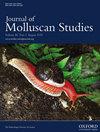Overlooked shell features: asymmetrical columellar folds in volutid gastropods
IF 1.2
4区 生物学
Q2 MARINE & FRESHWATER BIOLOGY
引用次数: 0
Abstract
Many gastropods have columellar folds, defined as continuous spiral ridges extending from the aperture to the shell interior on the adaxial side of the aperture. Despite their ubiquity, columellar folds have received little phylogenetic or functional study. In the vast majority of cases, columellar folds have a symmetrical profile, with the anterior (abapical) slope similar to the posterior (adapical) slope. Here I draw attention to the highly unusual phenomenon of asymmetry of columellar folds, where the anterior slope is markedly less inclined than the posterior slope of each fold. I have detected this condition in the volutid genera Scaphella Swainson, 1832; Cymbiola Swainson, 1831 and Lyrischapa Aldrich, 1911; as well as in the Palaeocene and Eocene genus Eovasum Douvillé, 1920. Following a review of Lyrischapa and Eovasum, I suggest that these two genera are closely related members of the volutid subfamily Indovolutinae, and that asymmetrical columellar folds have evolved three times in Volutidae. Although their function remains elusive, asymmetrical folds might prevent abapical displacement of the soft parts during rapid extension of the foot or feeding organs.被忽视的贝壳特征:涡腹类腹足动物不对称的壳褶
许多腹足类动物都有肠襞,肠襞的定义是孔口正面从孔口延伸到壳内部的连续螺旋脊。尽管它们无处不在,但对它们的系统发育或功能研究却很少。在绝大多数情况下,结肠褶皱具有对称的轮廓,其前部(背面)斜坡与后部(适应面)斜坡相似。在此,我提请大家注意极不寻常的结肠褶皱不对称现象,即每个褶皱的前斜率明显小于后斜率。我在涡虫属 Scaphella Swainson, 1832、Cymbiola Swainson, 1831 和 Lyrischapa Aldrich, 1911 以及古新世和始新世的 Eovasum 属 Douvillé, 1920 中发现了这种情况。在回顾了 Lyrischapa 和 Eovasum 之后,我认为这两个属是涡虫亚科 Indovolutinae 中关系密切的成员,而且不对称的结肠褶在涡虫科中已经进化了三次。尽管它们的功能仍然难以捉摸,但不对称的褶皱可能会防止软体部分在足或摄食器官快速伸展时发生背面移位。
本文章由计算机程序翻译,如有差异,请以英文原文为准。
求助全文
约1分钟内获得全文
求助全文
来源期刊

Journal of Molluscan Studies
生物-动物学
CiteScore
3.00
自引率
8.30%
发文量
36
审稿时长
3 months
期刊介绍:
The Journal of Molluscan Studies accepts papers on all aspects of the study of molluscs. These include systematics, molecular genetics, palaeontology, ecology, evolution, and physiology. Where the topic is in a specialized field (e.g. parasitology, neurobiology, biochemistry, molecular biology), submissions will still be accepted as long as the mollusc is the principal focus of the study, and not incidental or simply a convenient experimental animal. Papers with a focus on fisheries biology, aquaculture, and control of molluscan pests will be accepted only if they include significant advances in molluscan biology. While systematic papers are encouraged, descriptions of single new taxa will only be considered if they include some ‘added value’, for example in the form of new information on anatomy or distribution, or if they are presented in the context of a systematic revision or phylogenetic analysis of the group.
 求助内容:
求助内容: 应助结果提醒方式:
应助结果提醒方式:


